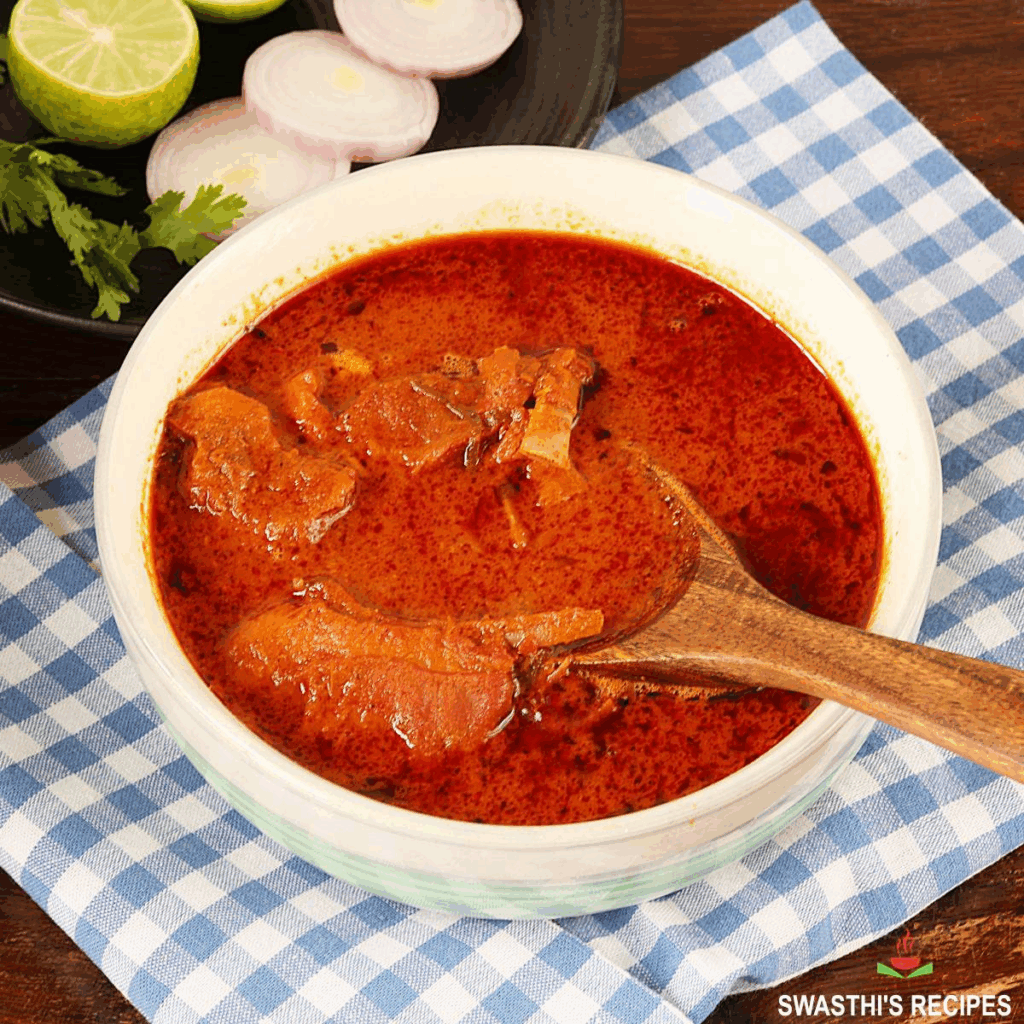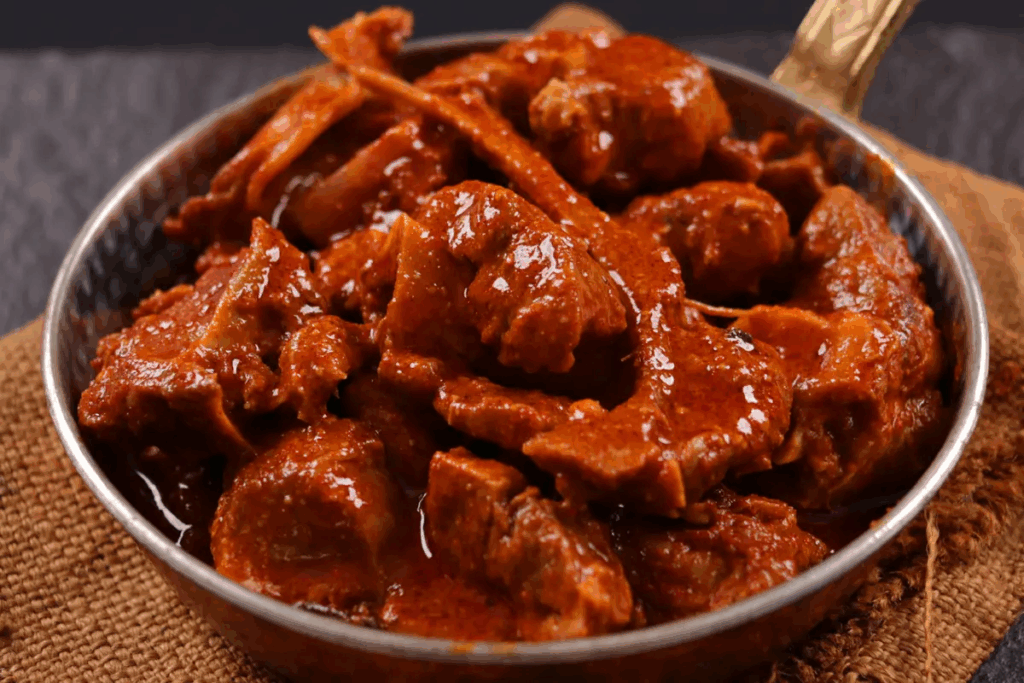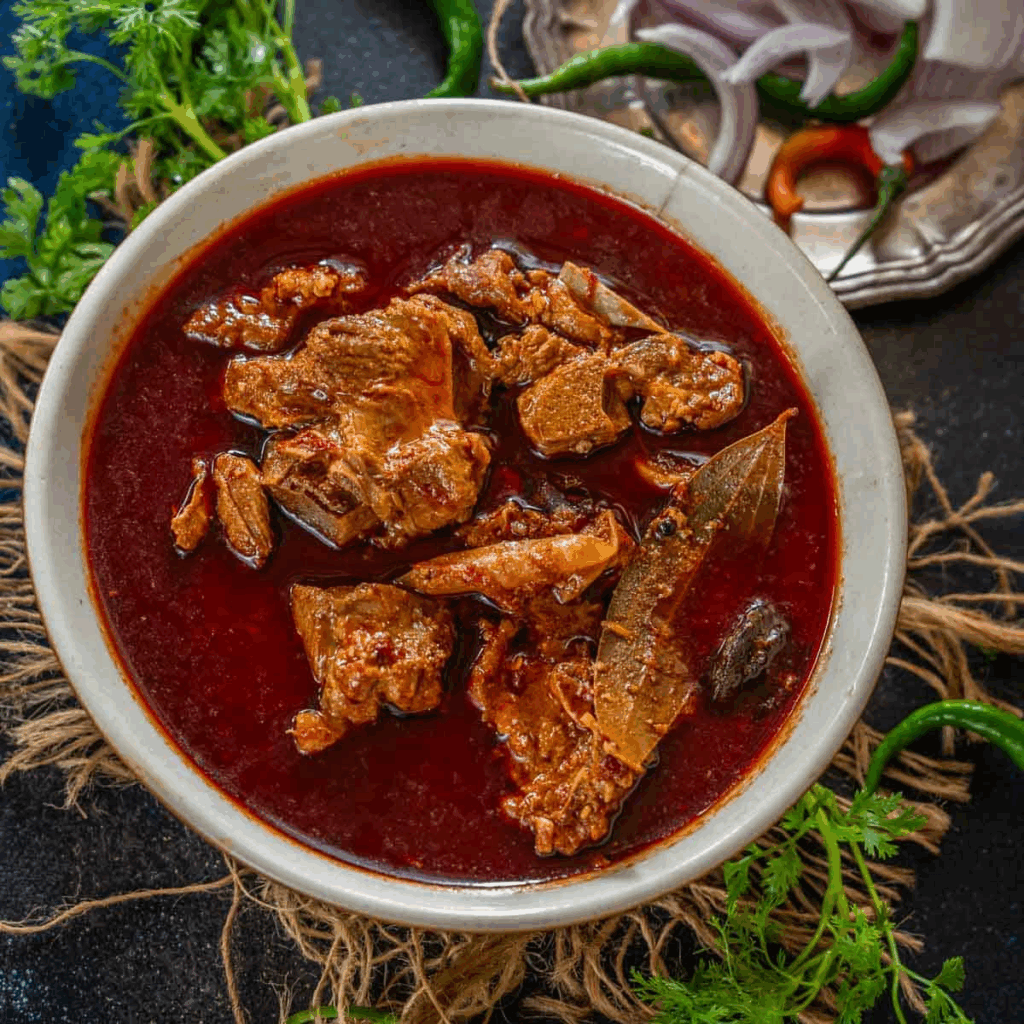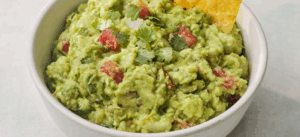What Is Rogan Josh and How to Make It at Home Like a Chef

In this guide, I’ll show you exactly how I make it—from selecting the right cut of lamb to building flavor step by step. You’ll also see how to adapt it to your own kitchen, no matter your equipment. It’s a dish worth learning—and once you master it, you’ll come back to it again and again.
- What Is Rogan Josh?
- Essential Ingredients I Always Use
- How I Build the Flavor Base
- Cooking Time Table by Method
- Meat Variations I’ve Cooked with Rogan Josh
- Vegetarian and Vegan Adaptations I’ve Developed
- Serving Rogan Josh with Perfect Pairings
- What to Serve as a First Course
- Reheating and Storage Tips That Preserve Flavor
- How I Layer Flavors for Maximum Depth
- Common Mistakes Home Cooks Make with Rogan Josh
- Creative Leftover Ideas (Chef-Tested Table)
- How I Plate Rogan Josh for Visual and Flavor Impact
- What to Serve with Rogan Josh for a Full Meal
- Spice Customizations I Use for Regional Flair
- FAQ – 15 Common Questions About Rogan Josh (with My Personal Answers)

What Is Rogan Josh?
Rogan Josh is a slow-cooked Kashmiri curry, traditionally made with lamb and deeply aromatic spices. Despite its bold red color, it’s not fiercely spicy—instead, it’s rich, warming, and beautifully balanced. The name comes from Persian: rogan means oil, and josh means intense heat. But don’t confuse that with extreme spiciness; it refers to the cooking technique—meat braised over sustained heat in richly spiced oil or ghee.
The dish traveled to India via the Mughals, and Kashmiri cooks adapted it with local chilies and yogurt. Over time, it’s become a staple in Indian restaurants worldwide. When made right, it’s a bold and fragrant lamb curry with a velvety red sauce.
Essential Ingredients I Always Use
To make a proper Rogan Josh, the ingredients must be clean and specific—there’s no room for cutting corners. On my experience, the flavor depends on a few key elements:
- Lamb shoulder or leg: cut into large cubes for long cooking
- Plain yogurt: for body and tang—added slowly to prevent curdling
- Kashmiri chili powder: gives the signature red hue without too much heat
- Whole spices: like cardamom pods, bay leaves, cinnamon, and cloves
- Ghee or mustard oil: crucial for depth
- Garlic and ginger paste: foundational in Indian cooking
- Ground coriander, cumin, fennel, and turmeric: for warmth and balance
- Salt and water or lamb stock: to control consistency
- Optional saffron: steeped in warm milk for luxury and color
I don’t use tomato in traditional Rogan Josh—it’s a common restaurant shortcut, but in the classical method, the color comes from chili and saffron. When sourcing Kashmiri chili powder, I make sure it’s fresh—older powder dulls the entire dish.

How I Build the Flavor Base
Making Rogan Josh isn’t difficult, but it’s about layering. I always begin by warming ghee or mustard oil in a deep pot, adding whole spices until they bloom. That’s when the kitchen begins to smell like something important is happening.
Then I add sliced onions—slow-cooked until golden. Garlic and ginger paste go in next. Once that sharpness mellows, in goes the lamb, which I sear until browned all over. This step is critical for depth.
The yogurt must be whisked and added gradually, with constant stirring. I’ve seen too many good curries spoiled by curdled yogurt—low heat and patience are key. I mix in ground spices and cook the mixture until oil starts to separate.
Finally, I add just enough hot water or stock to cover the lamb. The pot is then covered and left to simmer for 60–90 minutes until the meat is fork-tender and the sauce thickens. Near the end, I stir in saffron milk if I’m going all out.
Cooking Time Table by Method
Here’s a breakdown of how long Rogan Josh takes depending on how you cook it. I’ve used all these methods professionally and at home.
| Method | Prep Time | Cook Time | Total Time | Notes |
| Stovetop (Dutch oven) | 30 min | 90 min | 2 hrs | Classic method. Best balance of flavor and control |
| Oven (covered) | 30 min | 2 hrs | 2.5 hrs | Even cooking, great for larger batches |
| Slow cooker (low) | 30 min | 6–7 hrs | 7.5 hrs | Best for tenderness. Browning must be done beforehand |
| Pressure cooker | 30 min | 35–40 min | 1 hr 15 min | Fast and effective. Sauce may need reducing afterward |
| Microwave | 10 min | 20–25 min | 35 min | Only for reheating leftovers or simplified small portions |
When I want maximum flavor and texture, I always go with stovetop or oven. For busy days, I prepare the base the night before and drop it into the slow cooker in the morning.

Meat Variations I’ve Cooked with Rogan Josh
Traditionally, Rogan Josh is made with lamb, and in my kitchen, I default to lamb shoulder or bone-in leg for the richest result. But I’ve worked in enough diverse restaurants to try other proteins—each one brings something different to the table.
Goat is a natural substitute, especially in South Asian homes. It has a slightly gamier taste but works beautifully with the same spice base. I usually increase cooking time by 15–20 minutes for bone-in goat meat.
Beef chuck can be used, though it takes longer to tenderize. I found it works best when cooked low and slow, with an extra spoon of yogurt to round out the deeper flavor.
For a lighter twist, I’ve tried chicken thighs, marinating them first in yogurt and Kashmiri chili. The dish finishes quicker (about 45 minutes), and the result is flavorful, but softer in spice character.
Duck is a non-traditional but indulgent option. The rendered fat adds richness, especially when using whole spices like cinnamon and clove in larger amounts.
Whatever the meat, I always ensure it’s seared properly before braising—it’s what gives the sauce its backbone.
Vegetarian and Vegan Adaptations I’ve Developed
I often cook for mixed tables, and over the years I’ve crafted vegetarian versions of Rogan Josh that don’t feel like compromises.
My favorite plant-based base is mushroom and tofu. I brown cubes of tofu and sear mushrooms in oil to mimic the depth of meat, then proceed with the same spice mixture and yogurt—or cashew cream if I’m keeping it vegan.
Cauliflower florets and chickpeas also hold up well, especially when roasted beforehand. I add these in once the curry base is developed and let them simmer until they absorb the spices.
To keep the sauce thick and rich without animal products, I use ground cashews, coconut cream, or plant-based yogurt. I’ve also blended some of the onions into a puree to mimic the traditional gravy texture.
One memorable service involved pairing vegan Rogan Josh with saffron basmati rice and spiced okra, and honestly, no one missed the lamb.

Serving Rogan Josh with Perfect Pairings
Rogan Josh is deeply spiced and saucy, so it calls for simple but sturdy sides. The classic pairing is steamed basmati rice, and I often add a pinch of saffron or a bay leaf while cooking the rice for added aroma.
Another favorite of mine is Indian-style flatbreads like naan or paratha. The bread scoops up every bit of sauce and balances the richness.
When I want something more rustic, I serve it with jeera aloo (spiced potatoes), or earthy lentils like dal makhani. For freshness, a spoon of cucumber raita or red onion salad cuts through the heaviness.
And if you want a broader African-Asian fusion spread, consider Bantu-style chapati or even injera, especially if you’re serving guests with varied backgrounds. They absorb the sauce differently but beautifully.
I often plate Rogan Josh with three accompaniments: rice, flatbread, and something tangy or creamy to cool the spice.
What to Serve as a First Course
Because Rogan Josh is hearty, I keep starters light and aromatic to stimulate the palate without overwhelming it. My go-to first course is a simple lentil soup with ginger and cumin, served in small bowls with a sprinkle of fresh coriander.
If I’m leaning toward a restaurant-style experience, I prepare tandoori vegetables or grilled paneer skewers brushed with lemon and chaat masala. These set the tone for what’s to come without duplicating flavor profiles.
In cooler weather, I like serving a spiced carrot soup with a swirl of yogurt—it mirrors some of the same Kashmiri notes but remains mild.
When hosting guests, I sometimes prepare a chickpea salad with red onion, tomato, and tamarind dressing—it adds brightness and crunch, and gives a nod to Indian chaat culture.
These first courses are all designed to warm the appetite and give Rogan Josh its rightful spotlight when it arrives.
Reheating and Storage Tips That Preserve Flavor
Like many slow-cooked dishes, Rogan Josh actually improves with time. I often make it a day ahead, allowing the flavors to settle and deepen. When cooled and stored properly, it can last up to 4 days in the fridge.
After cooling to room temperature, I transfer the curry into a glass or ceramic container with a tight lid. I avoid plastic if the curry is hot, as the spices and oil can stain or leach flavor.
When reheating, I use a low flame on the stovetop, adding a splash of water or stock to loosen the sauce. Covering the pot helps the meat rehydrate. I never microwave large portions directly—it leads to uneven heating and toughened meat. However, for a quick solo portion, I microwave it covered with a damp paper towel and stir halfway through.
For longer storage, Rogan Josh freezes surprisingly well. I portion it into freezer bags, lay them flat, and label the date. When thawing, I always let it defrost overnight in the fridge—then reheat gently the next day.
How I Layer Flavors for Maximum Depth
What sets Rogan Josh apart is its multidimensional warmth—and that’s all about building flavor in layers. This is something I’ve learned from working both in Indian restaurants and fine dining kitchens.
I start by toasting whole spices—cinnamon, cardamom, bay, cloves—in hot ghee. This opens their essential oils. Next comes onion caramelization, a crucial phase that adds sweetness and color to the curry base.
The garlic and ginger paste sizzles in, cutting the sweetness and adding sharpness. Then the ground spices go in—coriander, turmeric, cumin, chili, fennel—and must be fried just long enough to release aroma but not burn.
Yogurt is gently folded in, with constant stirring to prevent curdling. This contributes creaminess and acidity. The seared lamb re-enters the pot, coated in this masala, before I pour in stock or water to begin the slow simmer.
Over the final 15 minutes, I often stir in saffron milk or crushed dried rose petals, depending on how luxurious I want the finish. These subtle notes bring an unmistakable elegance to the final dish.
Common Mistakes Home Cooks Make with Rogan Josh
Through classes and consultation, I’ve noticed a few common traps that many beginners fall into when making Rogan Josh—and here’s how to avoid them:
Using lean cuts of lamb: This curry needs fat and connective tissue to break down slowly. Lean meat gets dry and stringy. I always use shoulder or leg with some marbling.
Rushing the onion phase: Undercooked onions lead to sharpness instead of sweetness. I take at least 15–20 minutes on medium-low heat to properly brown them.
Adding yogurt too fast: Yogurt curdles easily. I whisk it first, lower the flame, and add it gradually. Stirring continuously avoids separation.
Overcrowding the pan while browning meat: I brown lamb in batches. Overcrowding causes steaming instead of searing and dulls the flavor base.
Skipping the resting period: After cooking, I let Rogan Josh rest for at least 15–20 minutes off heat before serving. This helps oils rise and flavors settle.
Creative Leftover Ideas (Chef-Tested Table)
When I have leftover Rogan Josh, I never repeat the same meal twice. Here are ways I reinvent this rich lamb curry in my kitchen, especially for the next day:
| Leftover Use | How I Do It | What It Pairs With |
| Rogan Josh Biryani | Mix with basmati, layer with saffron rice, bake covered | Raita, pickled onions |
| Lamb Wrap | Shred meat, roll with yogurt sauce in naan or chapati | Chopped salad or spiced fries |
| Curry-Stuffed Paratha | Chop meat, fold into dough, cook on skillet | Mint chutney or tamarind sauce |
| Lamb & Egg Curry | Reheat curry, crack in 2–3 eggs, cover and simmer | Soft bread or spiced couscous |
| Toasted Sandwich | Place meat and gravy in crusty roll, add cheese, grill | Pickled veg or potato chips |
These approaches prevent waste while turning leftovers into standout meals. The curry’s robust flavor holds up beautifully even after refrigeration.
How I Plate Rogan Josh for Visual and Flavor Impact
When I serve Rogan Josh, I treat it like the centerpiece it deserves. For home meals, a deep ceramic bowl works best—it holds heat and highlights the sauce’s rich, red color. I place the lamb chunks carefully, spooning sauce over them to let the oil shimmer on top.
For formal presentation, I go a step further. I lay a bed of saffron basmati rice first, then position the lamb on top in neat layers. A few whole spices from the pot—like a cinnamon stick or bay leaf—can be placed for drama.
I often garnish with fresh coriander leaves, a thin curl of fried onion, or a tiny spoon of yogurt thinned with lemon for brightness. A final drizzle of infused ghee (sometimes with garlic or fennel) brings aroma right to the table.
Plating isn’t just about looks—it’s about controlling the first bite. I arrange the dish to make sure every mouthful starts balanced between meat, spice, and rice.
What to Serve with Rogan Josh for a Full Meal
Rogan Josh is robust, so I pair it with lighter, cooling or starchy sides to complete the experience without competing flavors.
Aromatic basmati rice is essential. I sometimes mix in a little cumin or bay leaf, but never anything too bold that would clash with the curry.
Flatbreads like naan or roti are excellent for scooping. If you’ve made Bantu-style chapati recently, it pairs wonderfully as well.
For freshness, I include a simple raita—usually cucumber, mint, and yogurt. Its coolness balances the spice. I also serve thin sliced onions with lemon juice and green chili for crunch and acid.
When I want a deluxe spread, I add a vegetable side—like dry okra masala or sautéed spinach with garlic. A lentil dish like dal tadka rounds it out with creamy contrast.
These elements build a meal that’s not only filling but balanced—flavor, texture, temperature, and color.
Spice Customizations I Use for Regional Flair
Rogan Josh has a classic spice base, but over the years, I’ve tweaked it depending on my mood, region, or inspiration.
For a Hyderabadi twist, I add a pinch of garam masala at the end of cooking and finish with fried curry leaves. This adds sharpness and herbal heat.
If I want a North Indian hotel-style profile, I enrich the sauce with a spoon of cream and use onion puree for a smoother base.
In colder seasons, I blend in a pinch of nutmeg or mace for warmth. It reminds me of winter menus in the Himalayas.
When I’m inspired by Persian dishes, I steep a few threads of saffron in rose water, then fold it in just before serving. It’s not traditional, but it elevates the entire dish with floral depth.
As with all spice tweaks, I taste constantly and use restraint—each addition should support the lamb, not overshadow it.
FAQ – 15 Common Questions About Rogan Josh (with My Personal Answers)
Is Rogan Josh supposed to be very spicy?
On my experience, no. It’s rich and deeply spiced, but not burning hot. Kashmiri chili gives color, not excessive heat. If you’re heat-sensitive, reduce chili and build flavor from whole spices.
Can I use beef or chicken instead of lamb?
I’ve tried both. Beef chuck works well if cooked long enough. Chicken thighs also work—just reduce cooking time to avoid overcooking.
What’s the best cut of lamb?
From my kitchen tests, lamb shoulder is the best. It has fat and connective tissue that melt into the sauce. Leg works, too, but can dry out if overcooked.
How long should I cook Rogan Josh?
On stovetop, I give it at least 90 minutes for proper depth and tenderness. In a slow cooker, 6–7 hours on low is ideal.
Why does the yogurt curdle in the sauce?
That’s a common issue. I always whisk the yogurt and add it slowly on low heat. Stirring constantly prevents splitting.
Can I freeze Rogan Josh?
Absolutely. I portion it into bags or containers, freeze flat, and reheat gently on the stovetop. It actually tastes better after resting.
Is tomato used in traditional Rogan Josh?
In classical versions—no. Color comes from chili and saffron. Some modern recipes add tomato, but I avoid it unless doing a fusion variant.
Can I make it vegetarian?
Yes. On my experience, mushrooms and tofu make a great meatless base. Chickpeas and cauliflower are also excellent with the same spice base.
How do I tone down the spice if it’s too strong?
I stir in a bit of cream or yogurt, or serve it with extra raita and plain rice. A squeeze of lemon can also calm down heat without muting flavor.
What can I serve with Rogan Josh?
Basmati rice, naan, cucumber raita, and pickled onions are my top picks. You can also try it with Bantu-style chapati or even Ethiopian injera for something unique.
What’s the difference between rogan josh and curry?
Curry is a broad term. Rogan Josh is a specific Kashmiri-style lamb dish with a yogurt-based sauce and signature spice blend. It’s more focused and refined.
Is it okay to cook the dish ahead of time?
I recommend it. On my experience, Rogan Josh tastes better the next day. Let it cool, store it well, and reheat slowly.
How do I make it more luxurious?
I add saffron milk at the end or a few fried onions as garnish. Sometimes a touch of ghee or rose water adds a fine-dining flair.
Can I use ghee instead of oil?
Yes, and I often do. Ghee adds a nutty richness that supports the spice profile beautifully. It’s my default fat for this dish.
How can I make the sauce thicker?
Simmer uncovered at the end. You can also blend some of the onion base for smoothness. I avoid flour or starch—it dulls the taste.




Post Comment